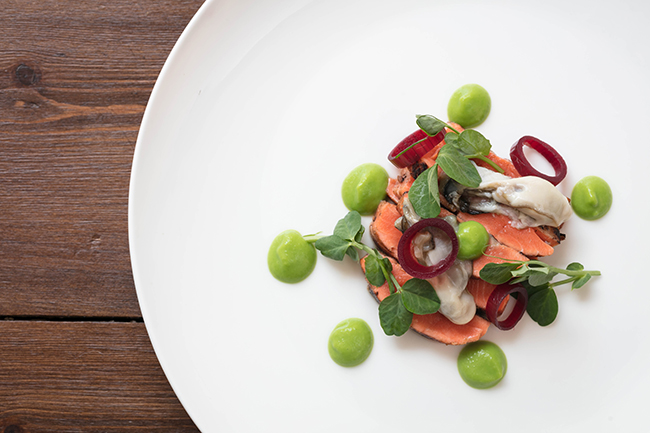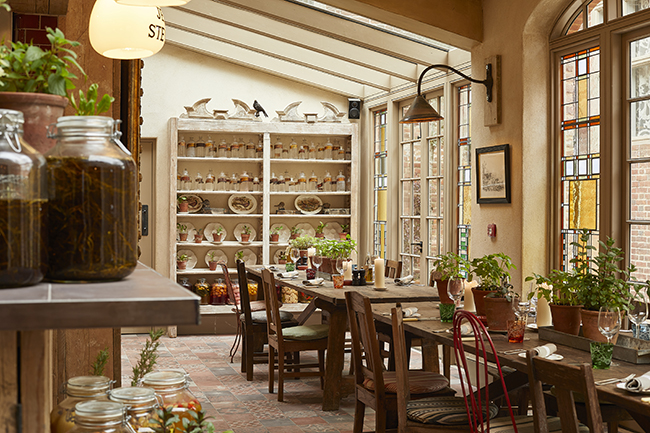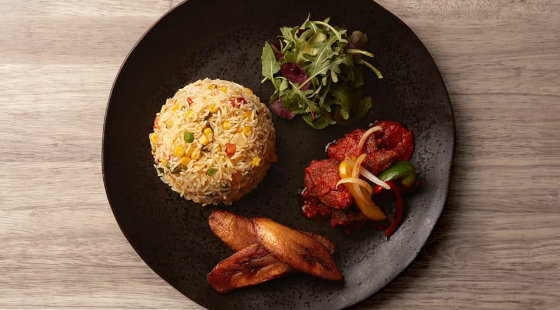Reviews: Kanishka in Mayfair, Darby's in Nine Elms and more
The cooking at Atul Kochhar's Kanishka in London's Mayfair is "elegantly balanced, yet admirably robust", according to Tom Parker Bowles in the Mail on Sunday
We eat Kolkata puchkas, also known as gol golpas, crisp, delicate bubbles of wheat, filled with soft potato, and a beetroot broth of startling purity, as clean as a Himalayan spring, with a robust chilli heat. Scallops, naga style, wear their capsaicin more gently, which accentuates rather than bludgeons that inherent sweetness.
It comes with ‘textures of cauliflower' too, one of those ‘feen deening' descriptions that makes the taste buds sag. There's a purée (there always is), a fried version and a decent chutney too. But that's as posh as it gets. Thank God.
No such modern affectations with a glorious venison keema ghotala, stella comfort food, lavishly spiced and piled thick and rich upon a buttery brioche bun. A squeeze of lime and pickled red onions cut through all that magnificent mince. Lamb momos are equally solid, with thickish, chewy pastry and a chilli spiked chutney with a healthy slug of vinegar. Sagolir manxo, or goat curry, is ambitiously priced at £26, but this is Mayfair and it's a beauty, heavy on the black pepper, chilli and cumin. We mop up every last smear.
Rating: 4/5. About £50 per head
The Evening Standard's Fay Maschler returns to Darby's
Smoked mackerel, grilled red peppers and Datterini tomatoes is a perky salad, but the fish a surprisingly fugitive presence. Native lobster brioche roll with roe mayo â" say that after a few Martinis â" is true to its American origins by virtue (not) of pronounced sweetness in the dressing.
The chicken arrives spatchcocked, laminated with a barbecue sauce and accompanied by a dear little pottery pot of gravy. The feeble texture and flavour of the flesh seems as if pre-cooked before application of the glaze. Skin is the best bit. A side dish of early summer vegetables ordered to up the vitamin content turns out to be an overcooked, over-buttered little stew with the abrasive flavour of chard dominating. We turn to the salad with renewed enthusiasm.
At a previous meal the soft billows and folds of Jersey milk ricotta agnolotti with Grezzina courgette & Nocerella olives in its delectability seems to have come from a different kitchen, one with closer ties to the estimable Sorella. Asparagus came when they were still in season. The tranche of head-on grilled fish is pleasingly gleamingly plain offset by the order of crispy beef fat potatoes, layered and ridiculously lush. Burnt honey cake and reduced-milk ice cream, its warm custard filling in a standoff with cold ice, is an ace dessert.
Rating: 3/5
Mana in Manchester is not just a good restaurant by Manchester standards but as âgood restaurant by world standardsâ, writes Marina OâLoughlin in The Sunday Times
The theatricality extends to dishes arranged with all the spectacle of the backdrop: the âEnglish tostadaâ, for instance, that arrives laden with juniper-scented fresh cheese and thyme, looking like the White Rabbitâs herbaceous border. Or those presented with full pantomime drama: the sultriest eel, smoky from the yakitori grill and glazed with blackcurrant vinegar and roasted yeast (like a glorious cross between soy sauce and Marmite); it arrives sizzling on stones before being whisked onto damp fabric to stop it cooking further. Or langoustine tails with cured egg yolk and a lick of thick tomalley bisque, lollipopped on spruce twigs, set afire.
Dishes are served by the chefs, young, earnest, garrulous. We learn that the tartare with fermented rhubarb and a posy of purple oxalis is from a former dairy animal, retired for nine years and dressed in its own rendered fat. And that the main ambition of this dish is, apparently, that it âtastes like beefâ. It does: like beef squared, beef to the power of beef, incredibeef. I swear, if you put it to your ear like a seashell, youâd hear mooing.
Price: 16 courses at £105 a head without drinks
William Sitwell describes Anna Haughâs Myrtle in Londonâs Chelsea as âthe best of Ireland⦠hospitable, cheery and upbeatâ in The Telegraph
Haughâs salmon â" albeit looking suspiciously like it had been blow-torched (the menu says roasted, which makes me think of ovens rather than sous vide and a flame) â" was wonderfully simple and delicate, and almost melted into the crushed potatoes.
It was a very finely judged and balanced plate with some watercress adding a peppery note, and a creamy sauce adding further juice and flavour.
The salmon was preceded by a thin length of black pudding wrapped in crisped potato. This was a miraculous little plate. God knows how you wrap a slice of potato around black pudding but the result is a fabulous juxtaposition of rustic flavour and fine-dining presentation; like a soot-covered miner doing a pirouette.
Rating: 4.5/5. Price: Dinner for two £75 without service or alcohol
My skate wing (from down the road in Rye) with capers and brown butter (accessorised by thrice-cooked chips, cabbage and bacon) was faultless without being in any way âYayâ-inducing. Though how much can one realistically expect of a skate wing? That its circumference might be an inch or two greater? That the flesh ratio might outweigh the bone?
A skate is only really ever as good as its cook, and this one was just right, but no more. Across the table, the âSouth Coast fish stewâ was deemed more of a soup, not so densely packed that there was a chance of finding Nemo.
Afterwards, a pretty strawberry buttermilk blancmange blushed and trembled like a fictional Edwardian bride, while Date declared the âAnnoâ gin-and-tonic jelly with elderflower sorbet to be a zinger.
Indeed, the only jarring note was the very upright, wooden dining chairs: If Iâm going to feel properly middle-class-assed, I need upholstery, or at least a fat cushion.
Rating: 4/5
The Observerâs Jay Rayner is enamoured with the laksa at Bugis Street Brasserie at the Millennium Gloucester in Londonâs Kensington
From the list headed âBugis Signaturesâ comes the classic nasi goreng, a huge plate of rust-coloured rice, mined with spiced chicken, prawns and a few peas for colour and pop, then topped with a fried egg, the yolk from which is just waiting to be pierced. With it comes a deep red sambal with huge toasted chilli notes with which to lubricate the rice and bring out the odd bead of sweat.
And then, of course, there is the laksa. Oh, the laksa. If, like me, you have a mental laksa map, a geographical plotting of the best places for the dish, drop a pin for this one. The thicker rice noodles take me by surprise; Iâm used to thinner vermicelli, but these have a satisfying slurp. The broth is not overly sweetened. Itâs a huge bash of chilli and stock and coconut. It bobs with prawns that have the bite of seafood cooked through only in the hot broth once it hit the bowl. I slurp and sip and dig about very happily.
Soups and starters £5.50-£9; mains £8.50-£17; desserts £6; wines from £18
The Evening Standardâs Jimi Famurewa reviews 805 in Londonâs Peckham, which he describes as âhypnoticâ West African food in âvisible-from-spaceâ portions
Boli was planks of roasted plantain, grill-kissed outside, tender, steamed and sweet within. The suya beef â" barbecued thin strips of meat marinated in a ferocious, peanut-laced chilli powder â" offered the perfect pleasure-pain see-saw of overwhelming spice and the compulsion to keep eating. Fish pepper soup, meanwhile, was atypically delicate: a thick, flaking raft of tilapia in a vast, fragrant broth humming with ginger.
There were mounds of jollof, of course, tangy and slightly smoky with a blooming lip-prickle of heat, wreathed in fried plantain, chicken and valiant suggestions of salad. Crimson tomato stew came ladled on chicken or daubed on fat prawns, with the necessary swell of Scotch bonnet and a detectable undertow of cooked-down dried shellfish. My egusi soup was a beef-studded, thrillingly unattractive expanse of melon seeds and spinachy bitterleaf that came with a creamy speed bump of mash-like pounded yam. Hypnotic, dense, nap-inducing. âMonikaâ fish, a dramatic whole grilled tilapia beneath a rugged hot sauce, is famous here but struck me as a bit of an overcooked chore, while the stewed beans were â" and youâll have to let me have just one of these â" nowhere near as good as my mumâs.
Ambience: 3/5; food: 4/5
The Timesâ Giles Coren is wooed by Mortimer House Kitchen in Londonâs Fitzrovia
From the âMedium platesâ we had a beautiful, multicoloured salad of Isle of Wight tomatoes, piled up with torn blobs of smoked burrata, sweet onion, basil and crispy bread, a plate of courgette spaghetti wound up with smoked ricotta, baby salad leaves and a chunky pistachio pesto and some magical herb tortelli, with pistachios again and smoked burrata and balsamic vinegar.
There was also a grilled Norfolk chicken on there, which I was fortunate to try the following Monday, when I ducked randomly into Mortimer House to shelter from some biblical rain and noticed it was lunchtime. The chicken was sweet and juicy with a lush, sticky gravy and a big grilled Amalfi lemon, mashing beautifully into another of those sweet potatoes and, bizarrely for a Monday afternoon at a time of âcarnageâ in the restaurant business, it was still utterly rammed.
Cooking: 8; space: 9; ambition: 10; score: 9. Price £50 per head without alcohol
The Packhorse Inn in South Stoke near Bath is âlike visiting a National Trust Building and going straight to the best part â" the tea roomâ, writes Grace Dent in The Guardian
A plate of spiced apple cake, more of a loaf, sticks in my mind, the sponge sweet and fragrant, and served with a dark puddle of pickled raisins the likes of which Iâve not tasted since the late 1970s, when my grandmother would turn all spare things to chutney.
The cake and raisins came armed with a wodge of Ashlynn goatâs cheese from Worcestershire, a semi-soft cheese thatâs hand-dipped in vegetable ash, giving it a slightly gothic appearance. I ate this with a small glass of Somerset cider brandy sitting in a stone-floored tap room next to what may be priest hideyholes, which have led some local historians to guess that the room dates from Henry VIIIâs first Act of Supremacy.
Other highlights of the menu on the Saturday we visited included a smoked beef hotdog in a bun served with jalapeños and a generous covering of crisp onions and vivid yellow American mustard. A well-judged piece of cod came on top of a gently curried bowl of quinoa dal made with grains from nearby Bath Farm Girls. Service was just as good, if a bit stretched, because the place is enormous. At its busiest, running it must be akin to crowd control.
About £30 a head for three courses à la carte, plus drinks and service. Food: 8/10; atmosphere: 9/10; service: 8/10





















